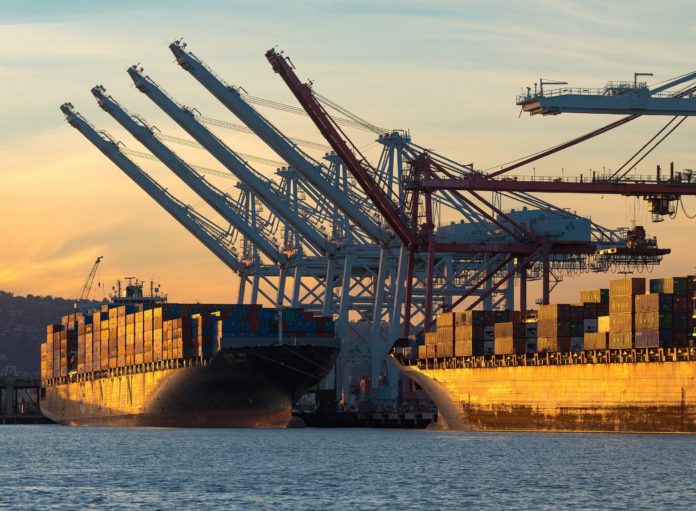Freight rates on the world’s two biggest routes, the Pacific and Asia/Europe trades, are on their way up as China’s manufacturing sector returns with a bang, but freight rate index provider Freightos says the consumers are now in lock down and the demand for goods is falling fast.
Amid the doom and gloom as the US and Europe fight to prevent the spread of Covid-19, headlines in the national press make for depressing, sometimes hysterical reading; some proclaiming that the majority of the world’s airlines are on the brink of bankruptcy and global trade could halve because of the virus.
In previous weeks the focus has been on Chinese supply, but as the outbreak spreads to the US and Europe, “Disruptions to western logistics to receive those goods in the near-term and the possible collapse of global demand are the new concerns,” said Freightos.
In addition some ports around the globe are looking to prevent the spread of the Covid-19 virus by closing ports to vessels that had left their preceding port less than 14 days previously. A situation that has been recognised by the International Chamber of Shipping (ICS) which has sent an open letter to a number of United Nations institutions, including the director and secretary generals of International Labour Organization, United Nations Conference on Trade and Development, International Maritime Organization and the World Health Organization.
The ICS letter, which was signed by Guy Platten, ICS secretary general and Stephen Cotton, general secretary at the International Transport Workers Federation (ITF), urged the UN bodies to keep ports open.
“In this time of global crisis, it is more important than ever to keep supply chains open and maritime trade and transport moving.
“In particular, this means keeping the world’s ports open for calls by visiting commercial ships and facilitating crew changes and the movement of ships’ crews with as few obstacles as possible,” said the letter.
The joint letter highlights the fact that 90% of the world’s trade is carried out by sea including the transportation of vital food and medical supplies.
The proportion of world trade carried by ships is likely to increase in the short term as airlines in the US and Europe stop operating, cutting the amount of ‘bellyhold’ cargo carried in passenger aircraft.
“Air cargo rates out of China are also spiking – a trend exacerbated by the removal of most of the belly capacity that normally travels with passenger flights. Some forwarders selling on the Freightos.com marketplace reported increases in prices of 40% over the last weeks, with some reporting more than 100% increases in the last few days,” said a Freightos report.
Much of this cargo will transfer to ships the only method for transporting goods.
Much of the critical cargo that needs to find a ship will also be in crisis as shutdown of manufacturing in China over the last month has led to the natural imbalance of reefer containers, becoming significantly worse. The natural imbalance on reefer heavy trades occurs because the reefer goods generally only travel in one direction, finding a backhaul cargo is often very difficult, and when one is found it does not necessarily require a reefer box.
Container XChange, a web-based container booking site, highlighted the problem when the company stated, “Coronavirus continues making equipment imbalances and empty container repositioning even worse for most carriers or NVOs (non-vessel operating carriers}. Especially in the US or Europe, companies are starting to experience frequent equipment shortages in several areas in the USA. This is a direct result of the ocean carriers’ blank sailing strategy which is triggered by the low/ no volumes on the major shipping routes.”
Alan Robertson, MD at Webster Robertson specialist reefer consultancy, said, “Tying in the northbound cargo with the southbound cargo is the perpetual problem for reefer operators, the round-trip costs are not necessarily paid.”
Robertson added that in any case “The space is not available [for reefers] and the reefer boxes are not in the right place.”
The Coronavirus has disrupted freight and thrown the supply-chain into chaos and it could take up to six weeks for it to “catch up,” explained Robertson.
The Freightos FBX index is showing rates on westbound on the Pacific trades had jumped 12% to US$1,497/FEU, as a result of the equipment shortages and the growing demand for capacity as China’s manufacturing gears back up.
Freightos added, “Trucking was one of the hardest hit links in the Chinese supply chain, with trucking rates in Italy already on the rise. Road transportation is so far largely intact in the US. But New Jersey has just introduced some road restrictions impacting trucking, and if the situation worsens more disruptions could be on the way.”
Meanwhile, on the Asia to North Europe trades freight rates have flatlined over the last seven days remaining at US$1,448/FEU as the impact of the virus develops.
Nick Savvides
Managing Editor







